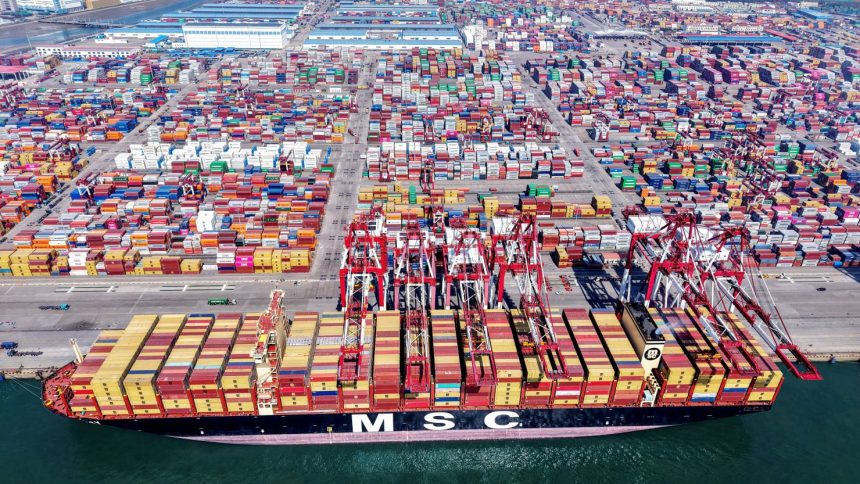Hong Kong
CNN
—
China has posted unexpectedly strong economic growth in the first three months of 2025, before the full force of US President Donald Trump’s tariffs took effect, and sent an upbeat message about how it plans to weather an ongoing trade war with Washington.
Growth in China’s gross domestic product (GDP) hit 5.4% in the first quarter, the National Bureau of Statistics said on Wednesday. That was considerably higher than the expectations of more than 50 economists surveyed by Reuters, who had predicted expansion of 5.1%, and continues a recent run of surprisingly strong export-driven growth seen at the end of 2024.
“The national economy had a steady and good start, continuing the upward trend,” Sheng Laiyun, deputy director of the NBS, told a news conference. “However, we must also see that the current external environment is becoming more complex and severe, and the effective domestic demand growth momentum is insufficient.”
Growth in China, the world’s second-largest economy, is in the spotlight as it deals with the fallout of an escalating trade war with the United States. And that’s on top of the economic problems it has faced for years: a crisis in the property sector, the specter of falling prices and a reluctance among consumers to spend.
The data announced by the NBS covers growth in the first quarter, a particularly eventful time for US-China trade relations. During that period, Trump imposed two rounds of tariffs totaling 20% on China related to fentanyl.
The figures do not include the impact of Trump’s additional “reciprocal” tariffs on Chinese imports, which took effect in April. The overall tariffs on China now exceed a staggering 145%.
Asked about the impact of the tariffs, Sheng noted that China opposes the US tariff barriers and “trade bullying.” While the tariffs will bring “certain pressure” to bear on the Chinese economy, they “cannot change the general trend of China’s continued long-term economic improvement,” he said.
“China’s economic foundation is stable, resilient and has great potential, so we have the courage, ability and confidence to cope with external challenges and achieve the established development goals,” Sheng added.
Consumer spending and production also beat expectations, with retail sales rising by 5.9% in March compared with the same month last year, and factory output expanding by 7.7% last month compared with 5.9% in the January to February period.
Growth prospects downgraded
Last month, Beijing set an ambitious target of “around 5%” growth for this year, in a defiant show of confidence in its export-driven economy. However, economists believe it will be tough to meet this target.
This is in part because export growth has been particularly buoyant since the waning months of 2024, when overseas companies increased their orders in anticipation of tariffs to be imposed by Trump.
Experts believe exports, which surged by 12.4% in March compared with the year before, will not be able to maintain that strong momentum in the coming months because of the triple-digit levies.
“We think the tariff shock poses unprecedented challenges to China’s exports and will set forth major adjustment in the domestic economy as well,” UBS economists led by Tao Wang wrote in a Tuesday research note.
They have downgraded their economic growth forecast for 2025 to 3.4% from 4%, with the assumption that the bilateral tariffs remain, and that Beijing will eventually announce additional stimulus measures.
Last week, investment bank Goldman Sachs said the US tariffs will “significantly weigh” on the Chinese economy. It has downgraded its GDP growth forecasts for 2025 and 2026 to 4% and 3.5%, respectively, from previous projections of 4.5% and 4%.
Zichun Huang, an economist at Capital Economics, wrote in a Wednesday research note that the government is likely to announce more measures to strengthen domestic consumption in the coming months, which she said should be enough to keep growth above 4%.
“The budget announced in March allows for a further ramp up in fiscal spending. And further monetary easing is likely to happen soon,” she said, referring to spending by government and moves by the central bank to make borrowing more accessible.
Diversifying trade
Like Chinese leaders at the opening of China’s parliament last month, Sheng has sought to project optimism in the country’s ability to stay the course, despite mounting trade pressure from the world’s largest economy and its mercurial president.
Sheng pointed out to reporters that China has been diversifying its trading relationships beyond the US since the first trade war with the US. China’s exports to the US as a percentage of total overseas shipments dropped from 19.2% in 2018, to 14.7% in 2024, he added.
“A diversified market pattern is taking shape, which also means that our dependence on a single export market in a certain country is declining,” he said. “Therefore, China’s foreign trade is relatively resilient. The just-released first-quarter foreign trade data also shows that despite the increase in external restrictions, exports still grew by 6.9%.”
On Wednesday, Beijing named Li Chenggang to the position of international trade negotiation representative and vice commerce minister. He replaced Wang Shouwen, who had played a major role in trade negotiations during Trump’s first term.
China is going on a global charm offensive to promote itself as a more politically and economically stable partner than the United States. Chinese leader Xi Jinping is currently on a week-long tour of Southeast Asia with that mission in mind.
As a bloc, the 10-country Association of Southeast Asian Nations overtook the US and the European Union as China’s largest export market in 2023. In meetings with Vietnam’s top leadership on Monday, Xi said the two countries should work together to maintain “the stability of the global free trade system and industrial and supply chains,” according to Chinese state news agency Xinhua.
This story has been updated with additional reporting and context.


